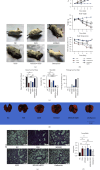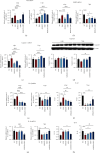Synergistic Therapeutic Effects and Immunoregulatory Mechanism of Maxing Shigan Decoction Combined with Sijunzi Decoction on Viral Pneumonia in Mice
- PMID: 39221016
- PMCID: PMC11364478
- DOI: 10.1155/2024/2017992
Synergistic Therapeutic Effects and Immunoregulatory Mechanism of Maxing Shigan Decoction Combined with Sijunzi Decoction on Viral Pneumonia in Mice
Abstract
Influenza is defined in traditional Chinese medicine (TCM) as an epidemic febrile illness and is usually treated with herbal compound formulas under the guidance of the "Qu Xie and Fu Zheng" theories. Ma Xing Shi Gan Tang (MXSGD) is a prominent remedy for clearing heat and detoxifying toxins in the clinical treatment of influenza in TCM, playing the role of "Qu Xie." Si Jun Zi Tang (SJZD) is recognized as one of the "Fu Zheng" formulas for strengthening the spleen and nourishing the stomach, with immunomodulatory effects. In this study, we followed the principles of "Qu Xie and Fu Zheng" to explore the effects of MXSGD combined with SJZD on viral pneumonia and its mechanism. Results showed that the couse of MXSGD and SJZD was effective in reducing the mortality rates and severity of lung pathology in lethally infected FM1 mice compared to the use of either drug alone. Moreover, further research demonstrated that the combined use suppressed TLRs and NLRP3 inflammatory signaling pathways at 4 dpi while promoting them at 7 dpi. At 10 dpi, there was a significant increase in CD11c+ and CD103+ DCs in the lungs. Together, SJZD improved the therapeutic effectiveness of MXSGD in treating influenza virus pneumonia than when used alone. MXSGD and SJZD exhibit synergistic effects in the treatment of influenza, as evidenced by the inhibition of TLR7 and NLRP3 inflammatory pathways early in the infection and facilitation of the response later. They also increase CD11c+ and CD103+ DC levels, as well as balancing Th1/Th2 cytokines.
Copyright © 2024 Huimin Huang et al.
Conflict of interest statement
The authors declare no conflicts of interest.
Figures







Similar articles
-
Exploring the immune-inflammatory mechanism of Maxing Shigan Decoction in treating influenza virus A-induced pneumonia based on an integrated strategy of single-cell transcriptomics and systems biology.Eur J Med Res. 2024 Apr 15;29(1):234. doi: 10.1186/s40001-024-01777-9. Eur J Med Res. 2024. PMID: 38622728 Free PMC article.
-
Potential effect of Maxing Shigan decoction against coronavirus disease 2019 (COVID-19) revealed by network pharmacology and experimental verification.J Ethnopharmacol. 2021 May 10;271:113854. doi: 10.1016/j.jep.2021.113854. Epub 2021 Jan 26. J Ethnopharmacol. 2021. PMID: 33513419 Free PMC article.
-
[Connotation of Xiao Chaihu Decoction combined with Maxing Shigan Decoction based on severe cases and modern pathophysiological mechanism and application for severe pulmonary infection and acute exacerbation of chronic obstructive pulmonary disease in critical care medicine].Zhongguo Zhong Yao Za Zhi. 2023 May;48(10):2606-2612. doi: 10.19540/j.cnki.cjcmm.20230215.501. Zhongguo Zhong Yao Za Zhi. 2023. PMID: 37282920 Chinese.
-
[Systematic review of randomized controlled trial of Maxing Shigan Decoction in treatment of community acquired pneumonia].Zhongguo Zhong Yao Za Zhi. 2021 Mar;46(5):1268-1275. doi: 10.19540/j.cnki.cjcmm.20200714.501. Zhongguo Zhong Yao Za Zhi. 2021. PMID: 33787122 Chinese.
-
The potential of Sijunzi decoction in the fight against gastrointestinal disorders: a review.Front Pharmacol. 2025 Mar 4;16:1464498. doi: 10.3389/fphar.2025.1464498. eCollection 2025. Front Pharmacol. 2025. PMID: 40103588 Free PMC article. Review.
References
LinkOut - more resources
Full Text Sources
Research Materials
Miscellaneous

